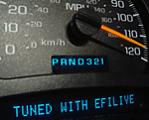This is all about giving a more in depth description about the new parameters we have added into our custom operating systems.
As new things are added this list will grow.
For A0000 to A0002 please read this intro.....
GM designed the LS1 PCM with a wonderful feature where the PCM has two main off idle spark maps, the 'High Octane' table and the 'Low Octane' table.
Generally the High Octane table will have timing values reasonably close to the optimum timing values for 'decent' quality fuel (i.e 95 to 98 Octane).
Then there is the Low Octane table which will have much lower timing figures designed to cope with situations where fuel quality maybe poor or a knock sensor failure (MAF failure as well, except EFILive's custom O.S's bypass that check).
The PCM uses a 'scaler' value that varies between 0% - 100%
100% indicates to the PCM to use '100%' of the value in the High Octane table, this scaler value can be reduced towards zero by excessive knock activity. If the PCM detects several knock conditions over a short period (about 3deg of retard) the scaler may drop to about 70 - 80%, this wil have the effect of droping the overall timing down as the PCM will now calculate the final timing figure from a 'mix' of the High Octane table and the 'Low Octane' table.
If the scaler was at 0% this would mean the PCM would only use the timing figures in the Low Octane map.
If the scaler was at 50%, it would do a 1/2 and 1/2 blend of the values in the High Octane table and the values in the Low Octane table.
The system works very well, except it can catch tuners out....here's how.
Lets say you are tuning a car on the dyno and the first run the Octane scaler is at 100%, you run the car up, it has some detonation, so the scaler all of a sudden drops to 91%, you proceed to give the car another run, same thing, there is some detonation and the scaler is bumped down to 78%. At this stage you are now down probably a few degrees of timing on the next run compared to the first run because the octane scaler is doing it's job and reducing the overall timing because the engine is knocking consistantly.
So the next run you decide to add some fuel in, all of a sudden the engine has some extra fuel, but you are still running that reduced timing figure, you might not know it, but you are. You figure it was too lean, that's why it was knocking, so the car comes off the dyno and the customer takes it away.
After giving the car a few hard stabs the customer settles down and drives home normally, by the time they have been driving for about 10 - 15mins the octane scaler has crept back up to 100% because the engine stopped knocking. Then, the driver gives the car a bootfull and it knocks....because all of a sudden the 2 - 3 degrees you lost on the dyno due to the scaler dropping has returned with some normal driving.
So the following parameters were added to enhance the functionality of the Octane scaler and to aid in tuning.
A0000 = Forced Octane Scaler
This option allows you to fix the Octane scaler to a percentage defined by parameter A0001.
This should only be used for tuning/development purposes.
See description for A0001 for further info.
A0001 = Forced Octane Scaler Percentage
Once A0000 is enabled you can now fix the Octane scaler to a percentage that will not change with knock retard.
Possible scenario is you are tuning a car that normally runs on 98 Octane fuel.
You fix the scaler to 100% and tune the High Octane table to it's optimum with good fuel without worrying about knock retard skewing the values as you try different values in the map.
Worth noting, knock retard still functions, it just means your Octane scaler will not move from 100%
Then, the customer states they sometimes run the car on 92 Octane, so you wait until the car has 92 Octane in the tank, set the scaler value to 0% and tune the Low octane table to suit.
Once tuned you can disable the forced scaler and return the PCM back to normal operation knowing the High Octane map is ideal for 98, and the Low Octane map is safe for 92 Octane.
This comes in very handy for the next parameter.
A0002 = Octane Scaler Limiter
This is used to limit the amount the Octane scaler can reach under no knock conditions.
After reading how A0001 works this can now be applied to the following scenario.
A car you tuned on 98 Octane is going on an interstate drive and the customer tells you they are pretty sure 98 Octane is not available, 95 is the best they can get.
Instead of remapping the High Octane map to 95, just set the Octane Scaler limit to say 60%, this will have the effect of dropping the overall timing down, plus allowing the PCM to scale the value down further if knocking continues and once the knock dissapears the scaler will not climb back upto the optimum timing for 98 Octane.






 Reply With Quote
Reply With Quote